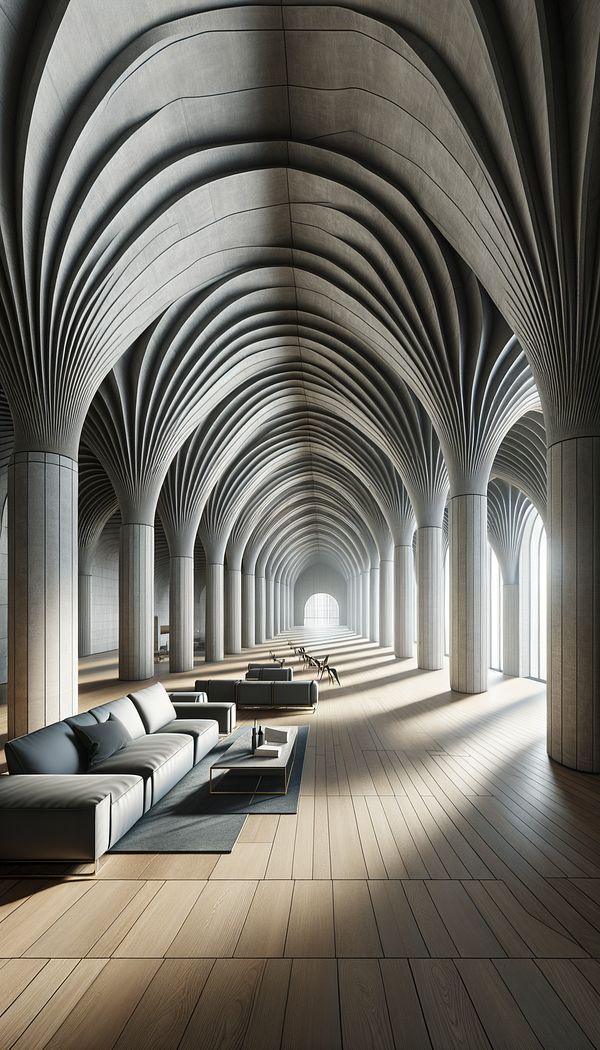What is a Barrel Vault?
A barrel vault, also known as a tunnel vault or a wagon vault, is an architectural element characterized by its semi-cylindrical shape.
Description
A barrel vault is a foundational architectural element that has been utilized for centuries, notable for its distinctive semi-cylindrical shape that resembles half of a barrel lying on its side. This form of vaulting is among the simplest forms of vaulting and is essentially a deep arch or an uninterrupted series of arches, one behind the other, over an oblong space. The technique involves creating a continuous curved surface that spans across the width of a room or a passageway, providing not only structural support but also a visually striking ceiling feature.
The beauty of a barrel vault lies in its simplicity and strength. It efficiently distributes the weight of the structure above, allowing for larger and more open interior spaces. Historically, barrel vaults were typically constructed using stone or brick, but modern versions might use concrete or steel, allowing for even greater spans and architectural flexibility. This method of construction has been adapted and evolved over time, allowing it to be incorporated into a vast array of architectural styles, from ancient Roman times to contemporary design.
The adaptability of the barrel vault means it can be seen in various settings, including sacred buildings, governmental structures, and residential properties. It adds an element of grandeur and spaciousness, making it a popular choice for high-end architecture and interior design projects.
Usage
In interior design, barrel vaults are often seen in entryways, corridors, or large living spaces where their structural capabilities allow for dramatic, open areas without the need for supporting columns. They can also serve aesthetic purposes, adding an architectural intrigue or a touch of historical grandeur to a space. Modern adaptations might include skylights or integrated lighting within the vault, enhancing its visual appeal and functionality.
FAQs
-
Are barrel vaults suitable for all types of buildings?
Barrel vaults are versatile and can be adapted for a variety of building types; however, their suitability depends on the specific structural requirements and aesthetic preferences of the project. They are particularly popular in buildings requiring spacious interiors and an architectural statement.
-
Can barrel vaults be used in modern architecture?
Yes, barrel vaults can be implemented in both historical recreations and contemporary designs. Modern materials such as steel and concrete have expanded their potential, allowing for greater spans and innovative applications in today's architecture.
-
What are the main benefits of using a barrel vault in design?
The main benefits include the structural strength and the ability to create large, open interior spaces without the need for additional support. Aesthetically, barrel vaults add an element of grandeur and continuity in architectural design.
Practical Application
When considering a barrel vault in an interior design project, it's important to assess the structural requirements and potential impact on the space. Pairing barrel vaults with natural lighting can enhance the grandeur and openness of the area. Consider integrating skylights or using reflective materials to amplify light within the space. The choice of material--whether historical (like brick or stone) or modern (such as steel or concrete)--should align with the overall design aesthetic and structural needs of your project.
-
Architectural Elements199 articles
-
Design Styles478 articles
-
Technical Terms38 articles
-
Space Planning & Layout134 articles
-
Construction & Building86 articles
-
LimewashLimewash is a type of paint made from limestone.
-
TV StandA piece of furniture designed to support a television and related media equipment.
-
Center GlideCenter Glide refers to a mechanism used in furniture design, especially in drawers, that allows for smooth opening and closing.
-
Hand DistressingHand distressing is a decorative technique used to give new furniture or materials an aged or weathered appearance.
-
MonochromaticMonochromatic refers to a color scheme that uses only one color.
